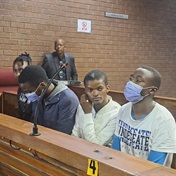Fewer than half of the country’s maize farmers were able to plant because of the drought, placing the country’s food security in peril.
This week is make or break after farmers in maize-growing areas who hoped for a wet Christmas were disappointed.
Maize farmers in the western areas of the country can, according to agriculture experts, still try to plant by Thursday, at the latest, but there is no rain in sight.
Of the 1.37 million hectares earmarked for white maize, less than half of it – 584 500ha – has been planted, according to statistics obtained from Free State Maize (FSM), a company that finances farmers to produce grain.
There are currently 1.4ha of yellow maize fields in production, compared with a 2.6 million-hectare target.
In Bothaville, known as the maize capital of the country, no more than a quarter of planned maize has been planted. The situation is so dire that farmers have started returning their seed and fertiliser.
It is estimated that with this year’s harvest and a surplus of 1 million tons of white maize in silos, there will only be enough white maize until October.
Omri van Zyl, head of Agri SA, said much of the white maize in the silos was already contractually linked. White maize was also not freely available internationally.
South Africa would be left with no choice but to import maize from Zambia and Mexico – at the mercy of the current weak exchange rate.
Adriaan Snyman, managing director of FSM, said this was the worst situation they had ever seen.
“When maize was selling at more than R3 000 a ton last year, many farmers sold their crops in advance.
“Now the prize of maize is R4 500 a ton and these farmers could not plant due to the drought.”
For those ready to plant this week, there is more bad news. No big rains are forecast for this week, although there will be scattered showers, according to Kgoloselo Mahlangu from the SA Weather Service.
Professor Francois Engelbrecht, head researcher for climate studies, modelling and environmental health research at the CSIR, said that from October to December the rainfall in Lesotho, KwaZulu-Natal and the eastern parts of North West was between 100mm and 200mm less than normal.
In Mpumalanga, Limpopo, the western parts of North West and the Eastern Cape interior, rainfall was between 50mm and 100mm lower than average.
“In some parts, not a single millimetre of rain was recorded. It is also the region with the country’s biggest reservoirs,” said Engelbrecht. “In addition, the drought has spread to the Cape south coast of George and East London, which escaped it until now.”
US space agency Nasa released new satellite images of the El Niño weather pattern and warned that the worst was yet to come. The image looks similar to the 1997 El Niño.
Big storms were still in store for the US, Nasa warned.
According to Engelbrecht, a silver lining for South Africa was that the pattern had begun to weaken here and would not continue after autumn.
“Often, after a strong El Niño, a strong La Niña follows, which is the opposite.
“It can be expected that South Africa will receive good, widespread rainfall in its next summer-rains season.”
However, this is cold comfort for farmers now.
Francois Strydom, managing director of agribusiness Senwes, said the main problem was now farm animals, as there had been very little production of livestock feed.
“Farmers are dipping into national reserves. Water is getting scarcer and dam levels are very low. They are dropping by 1% per week. The drought is now beginning to hit the whole country,” he said.
Tom Meintjies, head manager of cooperative GWK’s grain products, said it was not just maize being affected.
“The price of grain has increased from R3 600 a ton to R4 600 a ton. Pigs, chickens and most cattle are fed with grain before being slaughtered. Dairies feed almost all their animals grain in production. Grain prices have a big impact on the price of food in general, and consumers can expect strong food-price inflation in 2016.”
Van Zyl said AgriSA was leading a drought task team that would do a survey this month to determine exactly where it rained, who had planted and what they planted.
“Everything possible must be done to keep producers for food security. It is a critical situation,” said Van Zyl.




 Publications
Publications
 Partners
Partners








